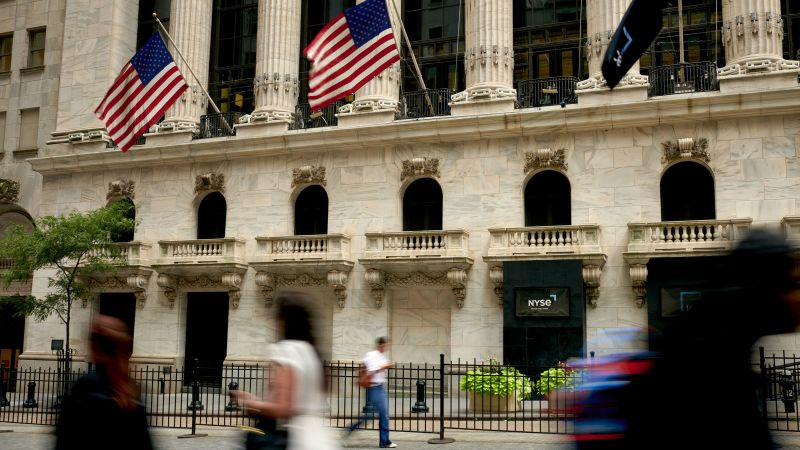A version of this story first appeared in CNN Business’ Before the Bell newsletter. Not a subscriber? You can sign up right here. You can listen to an audio version of the newsletter by clicking the same link.
Markets hate uncertainty, and there’s a lot of it this fall: The United Auto Workers union may strike on Friday, the federal government is heading toward another potential shutdown in October, geopolitical tensions with China remain heightened and oil prices could stay elevated through December. There’s also the looming question about whether the Federal Reserve will hike interest rates again.
All this uncertainty has led markets to lack conviction, flip-flopping as conflicting narratives around inflation rates and Fed hikes prevail. But this week’s readings — just a few days ahead of the Fed’s September policy meeting -— could give the markets direction.
If investors like what they hear, it could bring some much needed confidence to Wall Street. If they don’t like the data, it might push stocks lower.
What’s happening: Economists expect annual inflation as measured by the Consumer Price Index, due out on Wednesday, to have reached 3.6% in August, up from 3.2% in July.
A reading along those lines would be much lower than the CPI’s June 2022 peak of 9.1% but still well above the Fed’s 2% target rate.
On Thursday, the Producer Price Index, which tracks the average change in prices that businesses pay to suppliers, is expected to show an annual increase of 1.2%, up from 0.8% last month.
If inflation readings this week come in below those estimates, that could signal to traders that the Fed has hit its peak interest rate and will not hike further, said Jason Pride and Michael Reynolds of Glenmede, an investment and private wealth management firm. But if inflation proves stronger than expected, additional rate hikes could come later this year leading to more market indecision and volatility.
Financial markets see more than a 90% chance that Fed officials will vote for a pause at their policy meeting on Sept. 19-20, according to the CME FedWatch tool, but investors’ bets of another pause in November are lower, at around 54%.
A resilient labor market and forecasts of strong economic growth this quarter mean that inflation may stay higher for longer, prompting more fears that additional Fed rate hikes are on the way.
“Getting core inflation to 2% won’t come quickly, and upside risks remain,” said Greg McBride, chief financial analyst at Bankrate. Core inflation excludes volatile food and energy prices. “A disappointing CPI report could begin to frame expectations for another rate hike in the fourth quarter.”
All about oil: This month’s expected jump in inflation is due in large part to a surge in energy prices, say Bank of America analysts.
Prices jumped when Saudi Arabia and Russia — the world’s biggest crude exporters — said they would extend output cuts by at least another three months.
And while the Fed generally looks at core inflation, the impact of crude prices often extends into other areas of the economy.
“Higher oil prices also, of course, feed inflation psychology,” said David Kelly, chief global strategist of JPMorgan Asset Management in a note Monday. “There is no price in America better known than the price of a gallon of gasoline, so when gas prices rise, Americans often regard it as a sign of runaway inflation, leading to lower consumer confidence and greater business caution.”
For many lower- and middle-income Americans, he added, “spending more on gasoline means spending less elsewhere.” That’s a big deal. Consumer spending accounts for about 70% of the American economy.
Time is running short to avoid a strike at America’s three unionized automakers, and the distance between the United Auto Workers union and the companies remains large, reports my colleague Chris Isidore.
The contracts with the three automakers all run out at 11:59 pm Thursday, and UAW President Shawn Fain insists the union stands ready to go on strike Friday at any company that has not reached a tentative deal by then.
He admits the union’s demands are “ambitious” but he insists they’re justified, given the automakers’ strong profits in recent years.
So what exactly is the UAW asking for?
Chris outlines four key demands.
Raises: The union demands an immediate 20% raise, and then four additional raises of 5% each. Taken together they would increase hourly pay by 46% over the four-year life of the contract.
The UAW said Friday that GM and Ford are each proposing 10% increases in the hourly wage rate over the next four years in their most recent offers, while Stellantis, which makes cars in the US market under the Jeep, Ram, Dodge and Chrysler brands, is offering 14.5% raises.
Pensions and inflation adjustments: The UAW wants a return of traditional pension payment plans and retiree health care for all UAW members. Workers hired before 2007 still have those benefits. Those hired since — a majority of hourly workers — do not.
The union also wants to see a return to cost-of-living adjustments (COLA) to protect members from inflation.
Job protections and benefits: The union demands limits on the use of temporary workers and forced overtime. The union also wants more time off for workers, including a four-day workweek. And the UAW is fighting to gain certain job protections for workers, including the right to strike over plant closings.
A “just” transition to EVs: Union leaders say they’re not opposed to EVs but that it must be a “just transition.” As members lose their jobs building gasoline engines and transmissions, they should be able to shift to jobs building EV batteries and other parts, the union demands. Those jobs should pay the same scale that UAW-represented jobs at auto plants pay.
Instacart’s latest valuation is tens of billions of dollars below what the company was once worth just a year ago, reports my colleague Jordan Valinsky.
The grocery delivery company revealed in an updated IPO filing that it’s aiming to price its stock between $26 and $28 per share, valuing Instacart at around $7.4 billion at the midpoint. Taking into account restricted stock, options and warrants, the company would be valued as high as $9.3 billion.
It’s not all bad news for the company: Instacart said in its filing Monday that it has a “history of losses,” but “recently began generating profit.” For the first half of 2023, it generated $242 million in profit, compared with a $74 million loss for the same time period a year ago.
Read the full article here













Leave a Reply